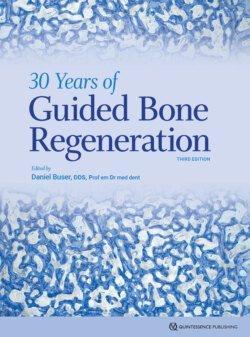30 Years of Guided Bone Regeneration

Реклама. ООО «ЛитРес», ИНН: 7719571260.
Оглавление
Daniel Buser. 30 Years of Guided Bone Regeneration
Отрывок из книги
30 Years of Guided Bone Regeneration
Third Edition
.....
The healing pattern of bone under a barrier membrane with the addition of various particulate bone fillers was analyzed in numerous experimental animal studies. One standardized animal model was introduced by Buser et al.106 In this model, which excludes the interference of the particular conditions in the oral cavity, standardized bone defects were created in the mandibles of minipigs with extraoral access. This study showed that particulate bone fillers have different biologic characteristics with regard to both bone formation potential and bone filler degradation dynamics. After 4 weeks, which was the earliest observation period in this study, significantly more new bone was formed when autogenous bone was used as a filler, as compared to DFDBA, a synthetic β-TCP biomaterial, and coral-derived HA (Fig 2-33).106 After 12 and 24 weeks, there was still more bone formation in the autogenous bone group than in the groups with DFDBA and coral-derived HA, but most new bone was found in the TCP group. On the other hand, TCP showed the greatest degradation rate, meaning that the volume of all three other fillers was more stable. Another important finding was that the autograft was the most osteoconductive filler material over the entire observation period (Fig 2-34).106 From this study, it was concluded that defects filled with autograft clearly demonstrated the best results in the early phase of healing and that the TCP biomaterial used showed a fast degradation and substitution rate.
Fig 2-33 Percentage of new bone in standardized bone defects in the mandibles of minipigs grafted with different materials. (Data from Buser et al.106)
.....